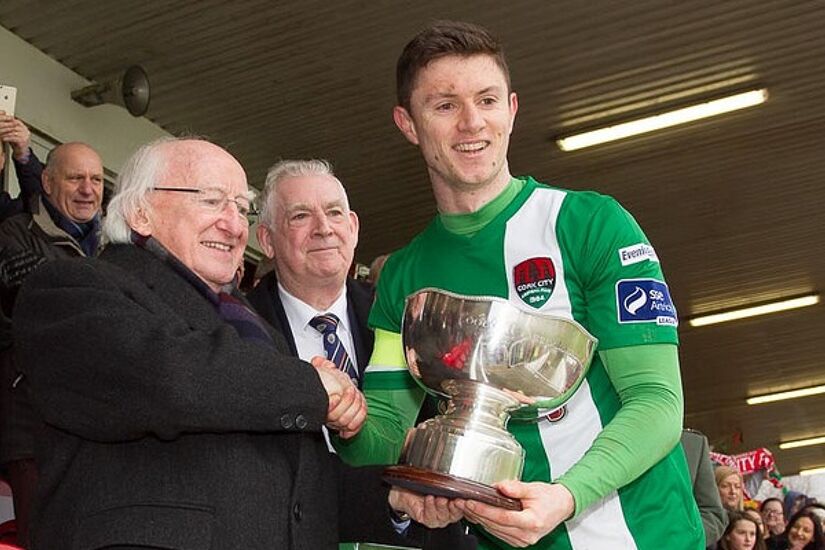When it comes to promotion, the League of Ireland needs to pull its own weight

Credit: Extratime Team (ETPhotos)
The Republic of Ireland's adventure at Euro 2016 in France – and the impeccable performance of the fans – has breathed new life into the national team and with it the way Irish football views itself.
Robbie Brady's 86th-minute winner against the Italians in Lille unleashed a wave of euphoria not seen since Robbie Keane's injury-time equaliser against Germany in Ibaraki.
Or, perhaps, not since Ray Houghton ruined the same opposition's day by chipping Pagluica at the Giants Stadium in New York back in 1994.
Yet, at home, all is far from rosy. Just as, four years ago, Irish fans partied while Monaghan United took its final breath as a league club (the former wasn't a response to the latter), once again crisis grips the League of Ireland.
Athlone Town lost almost an entire squad due after failing to pay modest expenses, while Waterford United are demonstrating how to lose friends and alienate people in a way that only Waterford United can. Both situations are being monitored by the FAI.
The success of Jack Charlton's side has widely been credited with inspiring a golden generation of Irish youths to take up football, resulting in Brian Kerr's European Championship-winning underage sides and the rise of Keane and Damien Duff.
Yet that success never filtered through to the national league, nor did it in 2002, yet the overwhelming feeling is that there is a certain amount of credit in the ledger which, if spent correctly, could really give the domestic game a boost.
Last week, then-Shamrock Rovers manager Pat Fenlon poured cold water on the idea that Ireland's Euro success would have a positive impact on gates in the League of Ireland.
"We've seen it before," he told RTÉ before his side's Europa League qualifier against Finnish side RoPS Rovaniemi.
"I've been involved in the league a long time. We've never got a real bounce from the national team doing well because I don't think the interest is there.”
Fenlon has his fair share of critics, but the Finglas man knows the league inside out and has been around long enough to know what has and hasn't impacted interest in the league.
He was duly proven right, as just 1,908 showed up to see the Hoops meekly surrender to a far from impressive RoPS side in Tallaght on Thursday night, 400-odd fewer than their average this season.
Clearly there are other reasons why the fixture didn't catch the imagination of fans – Fenlon was relieved of his position three days later – but it's obvious the feelgood effect hasn't transferred to domestic football.
In any ordinary week, Rovers could be expected to get 1,000 more at a game than cross-city rivals St Patrick's Athletic, who have a dedicated core of fans but a smaller latent support.
The Inchicore club actually posted a bigger attendance – 2,041 – for their Europa League first leg against Luxembourg side Juenesse Esch on Tuesday last.
Some of that could conceivably be linked to a positive boost from the Euros, but more likely it's simply the attraction of Europa League football and a first game in three weeks that brought the extra numbers in.
Certainly, league figures don't suggest there's been a boost – of the 10 teams to play at home in the first gameweek after the break, all but Shamrock Rovers (ironically) posted a figure below their average for the season.
That's not to suggest the Euros are to blame for a fall in attendances, nor that attendances won't pick up in the coming weeks, merely that there's no positive correlation between national team success and increased interest in the League of Ireland.
Which poses the obvious question: why not?
Fenlon offered his own theory – there simply isn't the interest there among national team fans. He may be right.
Yet what's clear is that League of Ireland clubs can increase interest, given success.
Fenlon's Shelbourne packed 25,000 into Lansdowne for a Champions League qualifier against Deportivo La Coruna in 2004. Rovers' attendances more than doubled following the move to Tallaght.
Dundalk's average attendance tripled in the three years after Stephen Kenny took over.
Yet every bubble bursts. Shelbourne now play to average crowds of 560 in the First Division. Rovers' attendances are down 42% on their 2011 peak.
Even likely three-in-a-row champions Dundalk are experiencing the trappings of success in Ireland – only two of their gates this season have matched or bettered last year's average, and those were the opening two games.
It seems that not even sustained success goes wholly unpunished.
So if the success of the national team doesn't help, and even success on the field is no guarantor, what exactly are clubs to do?
There are positive signs that the relationship between the FAI and the League of Ireland has developed slightly from last year when CEO John Delaney branded the league a “problem child.”
Martin O'Neill's Republic of Ireland squad contained eight players who began their careers in the League of Ireland, while two more – Kevin Doyle and David Forde – only narrowly missed the cut.
Compare that to the squad that Jack Charlton took to Italia '90 – only eight of that squad had ever lived in Ireland at any point in their life (though all but Niall Quinn of that eight had been on the books of a League of Ireland club).
A well-circulated photograph of the eight alumni – decked out in their former clubs' shirts – in Versailles showed how much goodwill can be created once everybody appears to be singing from the same hymnsheet.
That in itself isn't going to bring more faces to games, but it's a start, and so to is the association circling a poster for Rovers' game with Rovaniemi to mailing list subscribers the day before the game.
Again, it may have had little material effect on the crowd, but it provided an example of how simple it is to cross-promote the league on existing platforms – and completely cost-free – once all parties are on the same page.
The FAI and Irish football have taken a lot of flak in the past for their lack of promotion of the league – and the “problem child” comment was a nadir – but equally the association isn't the reason why Athlone Town could only attract 50 people to a cup tie.
Clearly the secret to a thriving league doesn't lie in the FAI suddenly developing a grá for the highest level of football in the country, but there are signs clubs are getting their act together and looking to pull their own weight.
Cork City have rightly been lauded for their promotion of the club over the past couple of years, as have Bohemians, while Shamrock Rovers have created a position of CEO for much the same purpose.
Dundalk have worked closely with their sponsor, Fyffes, over the past few years and it's hugely encouraging to see the banana men running a paid campaign on Youtube to push the partnership further.
That it's a huge multinational company (albeit a locally-based division) leading the way is instructive in a lot of ways.
There is an abiding sense within League of Ireland circles that, in some ways, promotion is risky, that you're better off investing on the pitch and competing there rather than taking a punt on expanding your supporter base.
And this view is probably borne out by experience in a lot of cases – it must be disheartening to put on a big push and attract a big gate, only to find yourself back where you started two weeks later.
Yet, as companies like Fyffes understand, marketing isn't a one-off expense – it's an ongoing activity that needs to be factored into any budget, whether it's a Fortune 500 company or a charity.
Quite simply, if Fyffes don't promote their fruit products, the Man from Del Monte will take over the banana racket. And he won't give up the fight as easily as some League of Ireland clubs will.
For the Man from Del Monte in this case, read Sky Sports and the Premier League, or Leinster Rugby, or Mr Bud Weiser, or anything else competing for people's attention on a Friday and Saturday night.
If the Man from Del Monte can do it in a leisure suit from the eighties, then surely it's possible for the League of Ireland to plot a brighter future in slightly less ridiculous get-up.

